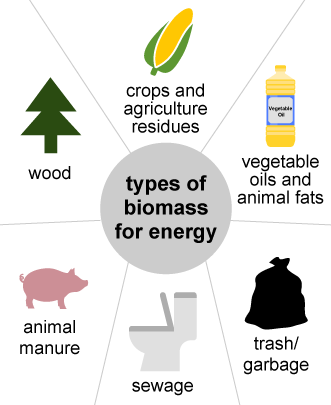Biomass—renewable energy from plants and animals
Biomass is renewable organic material that comes from plants and animals. Biomass was the largest source of total annual U.S. energy consumption until the mid-1800s. Biomass continues to be an important fuel in many countries, especially for cooking and heating in developing countries. The use of biomass fuels for transportation and for electricity generation is increasing in many developed countries as a means of avoiding carbon dioxide emissions from fossil fuel use. In 2021, biomass provided nearly 5 quadrillion British thermal units (Btu) and about 5% of total primary energy use in the United States.
Biomass contains stored chemical energy from the sun. Plants produce biomass through photosynthesis. Biomass can be burned directly for heat or converted to renewable liquid and gaseous fuels through various processes.
Biomass sources for energy include:
- Wood and wood processing wastes—firewood, wood pellets, and wood chips, lumber and furniture mill sawdust and waste, and black liquor from pulp and paper mills
- Agricultural crops and waste materials—corn, soybeans, sugar cane, switchgrass, woody plants, and algae, and crop and food processing residues, mostly to produce biofuels
- Biogenic materials in municipal solid waste—paper, cotton, and wool products, and food, yard, and wood wastes
- Animal manure and human sewage for producing biogas/renewable natural gas
Converting biomass to energy
Biomass is converted to energy through various processes, including:
- Direct combustion (burning) to produce heat
- Thermochemical conversion to produce solid, gaseous, and liquid fuels
- Chemical conversion to produce liquid fuels
- Biological conversion to produce liquid and gaseous fuels
Direct combustion is the most common method for converting biomass to useful energy. All biomass can be burned directly for heating buildings and water, for industrial process heat, and for generating electricity in steam turbines.
Thermochemical conversion of biomass includes pyrolysis and gasification. Both are thermal decomposition processes in which biomass feedstock materials are heated in closed, pressurized vessels called gassifiers at high temperatures. They mainly differ in the process temperatures and amount of oxygen present during the conversion process.
- Pyrolysis entails heating organic materials to 800–900oF (400–500 oC) in the near complete absence of free oxygen. Biomass pyrolysis produces fuels such as charcoal, bio-oil, renewable diesel, methane, and hydrogen.
- Hydrotreating is used to process bio-oil (produced by fast pyrolysis) with hydrogen under elevated temperatures and pressures in the presence of a catalyst to produce renewable diesel, renewable gasoline, and renewable jet fuel.
- Gasification entails heating organic materials to 1,400–1700oF (800–900oC) with injections of controlled amounts of free oxygen and/or steam into the vessel to produce a carbon monoxide and hydrogen rich gas called synthesis gas or syngas. Syngas can be used as a fuel for diesel engines, for heating, and for generating electricity in gas turbines. It can also be treated to separate the hydrogen from the gas, and the hydrogen can be burned or used in fuel cells. The syngas can be further processed to produce liquid fuels using the Fischer–Tropsch process.
A chemical conversion process known as transesterification is used for converting vegetable oils, animal fats, and greases into fatty acid methyl esters (FAME), which are used to produce biodiesel.
Biological conversion includes fermentation to convert biomass into ethanol and anaerobic digestion to produce renewable natural gas. Ethanol is used as a vehicle fuel. Renewable natural gas—also called biogas or biomethane—is produced in anaerobic digesters at sewage treatment plants and at dairy and livestock operations. It also forms in and may be captured from solid waste landfills. Properly treated renewable natural gas has the same uses as fossil fuel natural gas.
Researchers are working on ways to improve these methods and to develop other ways to convert and use more biomass for energy.
How much biomass is used for energy?
In 2021, biomass provided about 4,835 trillion British thermal units (TBtu), or about 4.8 quadrillion Btu and equal to about 5% of total U.S. primary energy consumption. Of that amount, about 2,316 TBtu were from biofuels (mainly ethanol), 2,087 TBtu were from wood and wood-derived biomass, and 431 TBtu were from the biomass in municipal solid wastes and sewage, animal manure, and agicultural byproducts.
The amounts—in TBtu—and percentage shares of total U.S. biomass energy use by consuming sector in 2021 were:
- industrial—2,313 TBtu—48%
- transportation—1,477 TBtu—31%
- residential—464 TBtu—10%
- electric power—435 TBtu—9%
- commercial—147 TBtu—3%
The industrial and transportation sectors account for the largest amounts, in terms of energy content, and largest percentage shares of total annual U.S. biomass consumption. The wood products and paper industries use biomass in combined heat and power plants for process heat and to generate electricity for their own use. Liquid biofuels account for most of the transportation sector’s biomass consumption.
The residential and commercial sectors use firewood and wood pellets for heating. The commercial sector also consumes, and in some cases, sells renewable natural gas produced at municipal sewage treatment facilities and at waste landfills.
The electric power sector uses wood and biomass-derived wastes to generate electricity for sale to the other sectors.
The United States is net exporter of biomass energy
On an energy content basis, the United States exported more total biomass energy than it imported in 2021. In 2021, the United States was a total biofuels net exporter.
Densified biomass fuels (wood pellets and other densified biomass fuels) have become a U.S. export commodity in recent years. In 2021, the United States exported about 8 million tons of wood fuel pellets (see Table 8).
Last updated: June 2, 2022, with most recent data available at the time of update; data for 2021 are preliminary.



